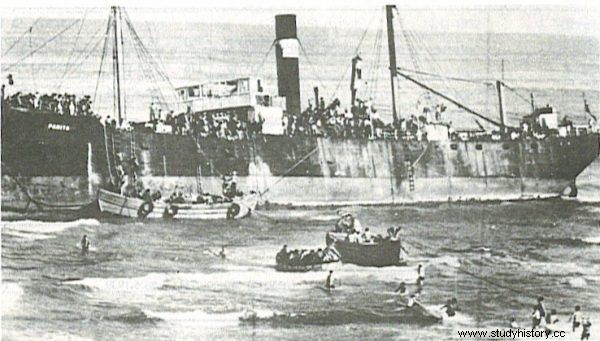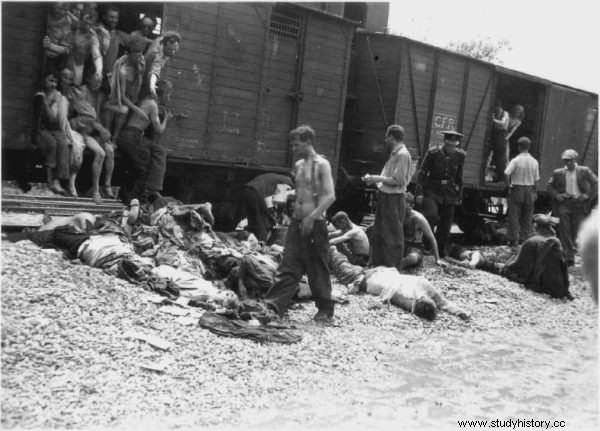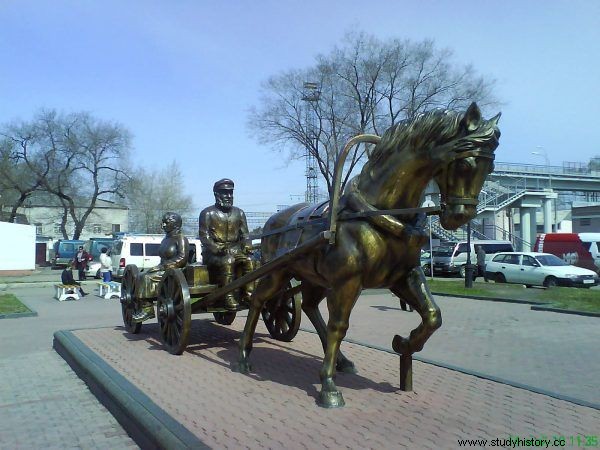The Germans were not the only anti-Semites in pre-war Europe. Politicians from other countries also devised radical, inhuman and often simply absurd solutions to the Jewish question. Romania, the Soviet Union and also - Poland.
In 1939, nearly 10 million Jews lived in Europe, but their number decreased across the continent. Progressive assimilation, emigration overseas and to Palestine and very low fertility resulted in predicted demographic catastrophe and extinction .
In Germany alone, between 1925 and 1933, i.e. in the decade before the Nazis came to power, the number of Orthodox Jews dropped by as much as 11%. Yet this did not diminish the belief of many governments and citizens that the Jews should not be allowed to "perish" by themselves. There were voices in almost every country that they should be helped in their extermination.
Jews in Madagascar!
In Poland, where over 3 million Jews lived, a significant shift in the policy towards this minority took place after the death of Józef Piłsudski. His successors were much more succumbing to nationalist, anti-Semitic rhetoric, and felt it would be best to get the Jews out of the country. In 1937 it was announced that the goal of the ruling camp was the emigration of 90% of the Orthodox Jews from the Second Polish Republic.

Farming conditions in Madagascar are not easy. Would Jewish settlers cope with unfamiliar surroundings? (Photo:Bernard Gagnon, CC BY-SA 3.0).
But where to send 3 million people? The first idea was French Madagascar. It was not an original thought. In Western Europe, the island was indicated as a potential place for Jewish settlement since the 19th century. This option was even considered by some Zionists . The government in Paris initially considered consent and a Polish delegation went to the Indian Ocean to assess the settlement conditions there.
After inspection, it was certainly too optimistic that as many as 50,000 people could immediately settle in the French colony. Jews. Then, however, its inhabitants protested, as well as nationalists from the Seine, who feared losing the island to the followers of Judaism. In turn, Polish nationalists unexpectedly shouted: Madagascar only for Poles! The project failed.
For your freedom and our… freedom from you
In this situation, a somewhat surprising alliance took place. Sanation authorities allied with radical Zionists whose goal was to establish a comprehensive Jewish state in Palestine as soon as possible. As Timothy Snyder writes in his book "Black Earth":
The Polish Foreign Minister and other diplomats publicly called on the British to ease immigration restrictions and establish a Jewish home as soon as possible. Poles had a very specific vision of such a creation - a Jewish, independent Palestine, as large as possible and with access to the Red Sea. This meant that it would extend along both banks of the Jordan.

Ship with Jewish settlers in the port of Tel Aviv, August 22, 1939 (photo:public domain).
The words did not end there. In 1937, Sanation authorities offered weapons and military training to members of the Haganah , that is, Jewish self-defense in Palestine, which became the mainstay of the Israeli army after the war. A year later, a similar offer was made to the National Armed Organization, also known as the Irgun. It was created by radical Haganah splitters who carried out terrorist activities in the Middle East.
In the same year, in Volhynia, exercises with the participation of Jewish fighters began. The Polish consul in Jerusalem was informed in advance about the Irgun actions, and one of its leaders worked as an agent of our intelligence. Timothy Snyder believes that: Polish authorities have engaged in a pro-Zionist conspiracy , which the Nazis would find completely incomprehensible - if they knew about it.
All this can be summed up with the slogan: For our freedom from you .
The attitude of the British who ruled Palestine turned out to be an insurmountable obstacle. Arab resistance and fear of losing control of the territory prompted the government in London to dramatically reduce Jewish immigration.
Romanian Holocaust
In 1919, at a conference in Paris, Romania was forced to grant Jews full equality. The same was demanded of Poland, and both countries protested - unanimously, but to no avail.
In 1937, one hundred and fifty thousand Jews were revoked Romanian citizenship. In 1940, all representatives of this nationality were deprived of the rest of their rights, introducing legislation modeled on the German. The worst was yet to come.
As Timothy Snyder emphasizes in "Black Earth": Romania (...) was the only country - apart from Germany - with its own policy of direct mass murder of Jews .

On June 27, 1941, Romanian soldiers initiated a pogrom in Iasi, during which at least 8,000 were killed. Jews. Another 5 thousand. they were rushed to two freight trains (one hundred people per wagon) and driven aimlessly around the surrounding areas for 8 days. Many died of hunger, thirst and lack of air (photo:public domain).
The authorities in Bucharest used a rhetoric similar to the German one about Judeo-Bolshevism and the treacherous cooperation between Jews and the Soviets. Among other things, this was to… protect Romanian collaborators who were not to be blamed.
Planned executions took place wherever Romanian troops entered Jewish population and inspired pogroms. The survivors were deported to specially created concentration camps, where they died en masse. In Odessa alone, 26,000 were shot. people. In total, the number of Jewish victims of Romanians is estimated at around 280,000 .
It is worth noting that such a fate befell only the Jews in the territories confiscated from the USSR. In Romania alone, "only" 15,000 Orthodox Jews died - 97% of the total survived. However, this was not at all due to the pity of the government in Bucharest. Just when the scales of victory in the war began to tip over to the enemies of the Third Reich, Romanian politicians decided that further extermination was too risky and refused to deport "their" Jews to Auschwitz. In 1944, this decision made it easier for Romania to switch to the Allied side.

Romanian soldiers in Constanta, 1941 (photo Bundesarchiv, N 1603 Bild-030 / Horst Grund / CC-BY-SA 3.0).
The Promised Land in Soviet Hell?
In the USSR, the attitude towards the Jewish population of three million people was theoretically very good. Formal equality allowed the development of the press, education, literature and art in Yiddish. Everything, of course, under the strict control of the state, which took care of the ideological correctness of this activity.
However, the cost of these "privileges" was very high. The communist struggle against all religion hit the foundations of Jewish identity. Moreover, 2/3 of all Jews were considered the so-called lichen men, or alleged representatives of the old exploiters. They were deprived of their fundamental rights , limiting access to education, health and even food.
There were also efforts to force the resettlement of Jews from cities to villages, and for this purpose, five Jewish ethnic regions were established in Ukraine and Crimea. They began to depopulate as soon as their inhabitants were allowed to return to the cities.
However, Stalin did not lack bold - or rather crazy - ideas. In 1928, the settlement of Jews began ... in the vicinity of Birobidzhan at the present-day border with China. In 1934, a Jewish Autonomous Oblast was established there, with an area larger than the British-administered Palestine.

Monument to the settlers in Birobidzhan (photo:Glucke, CC BY-SA 3.0).
The plans were ambitious, but the implementation was typically Soviet. The settlers often had to live in huts, they were plagued by hunger and disease . Anyone who could, would return to where he had come from, so that the fugitives had to be stopped by the NKVD.
Instead of well over 100,000 Jews, only 18,000 remained in the Far East, and the most active of them became victims of the Stalinist purges. Nevertheless, the district continues to exist today under the same name as well as the local Jewish drama theater. However, Jews constitute only less than 2% of the population of this area.
Europe - the continent of camps
The end of the 1930s was a growing problem for Jewish refugees. Thousands of people were looking for a way out of the Third Reich and the areas annexed by it, and another thousands were deported from Romania, Yugoslavia, Germany or Hungary as citizens of other countries. They often became stateless as no one wanted to accept them.

The article was based, inter alia, on on Timothy Snyder's book "Black ground. The Holocaust as a warning ”(Znak Horyzont 2015).
Desperate, they even sought refuge in Shanghai where at least 18,000 European Jews had arrived, but the Japanese controlling the city quickly announced that they would not allow refugees. Plans for settlement in Australia, Kenya, Sudan, Brazil or French Guiana, and even in Alaska but they all backfired. More or less oppressive refugee camps were established in other European countries.
Bernard Wasserstein, author of the book “On the eve. Jews in Europe Before World War II ”, aptly commented:
Even if no one could predict Auschwitz, any observer of the European Jewish community in 1939 could not view its future except with deep pessimism.
